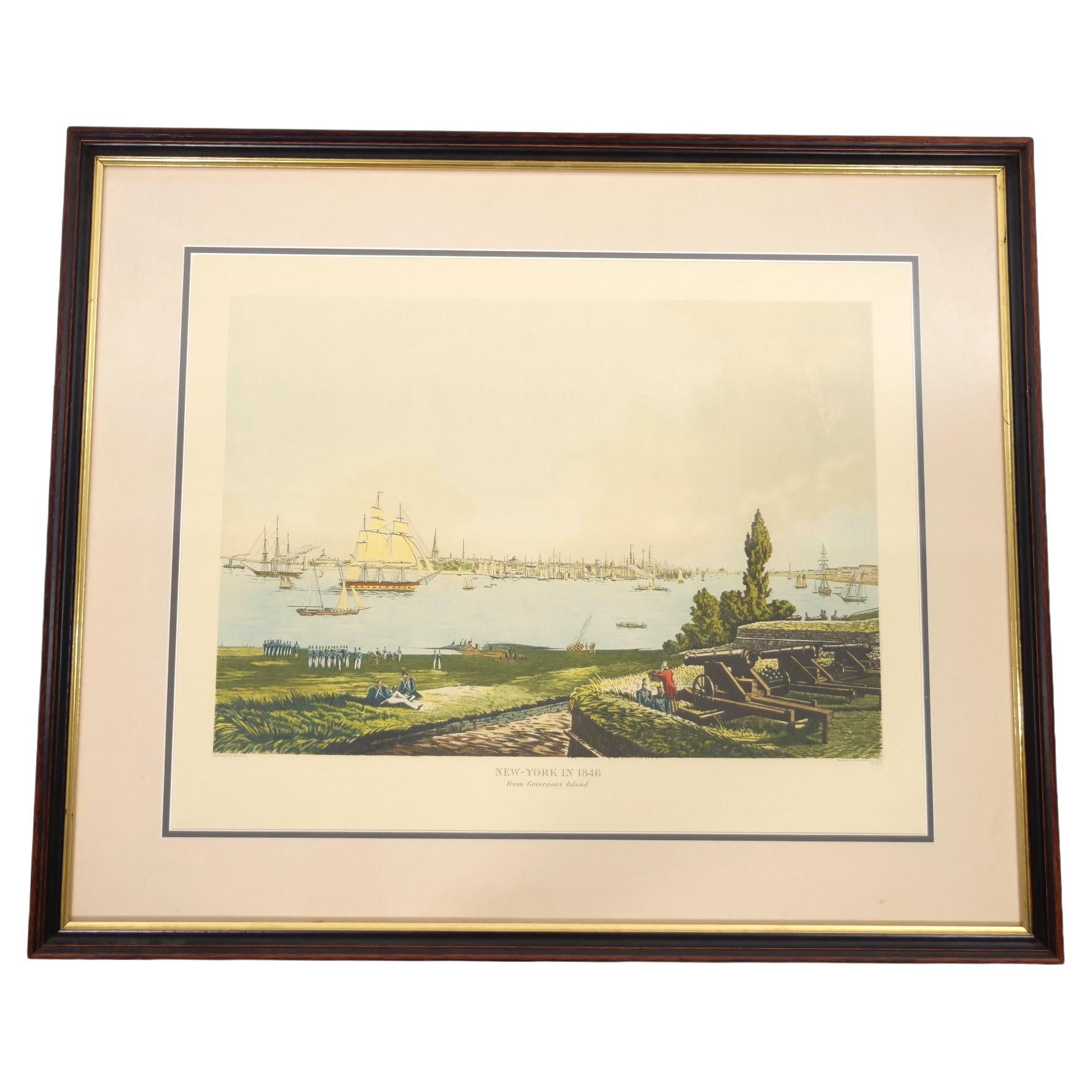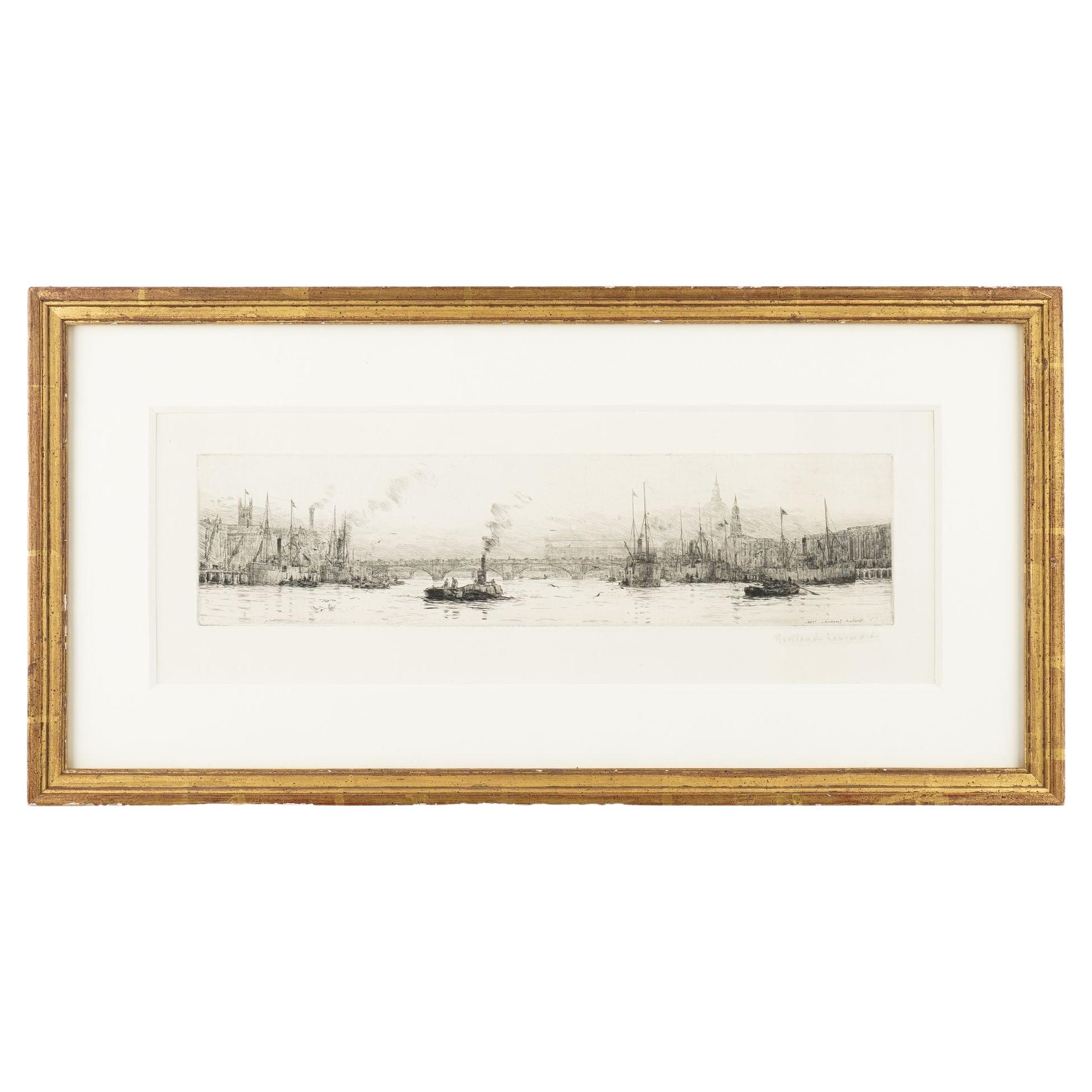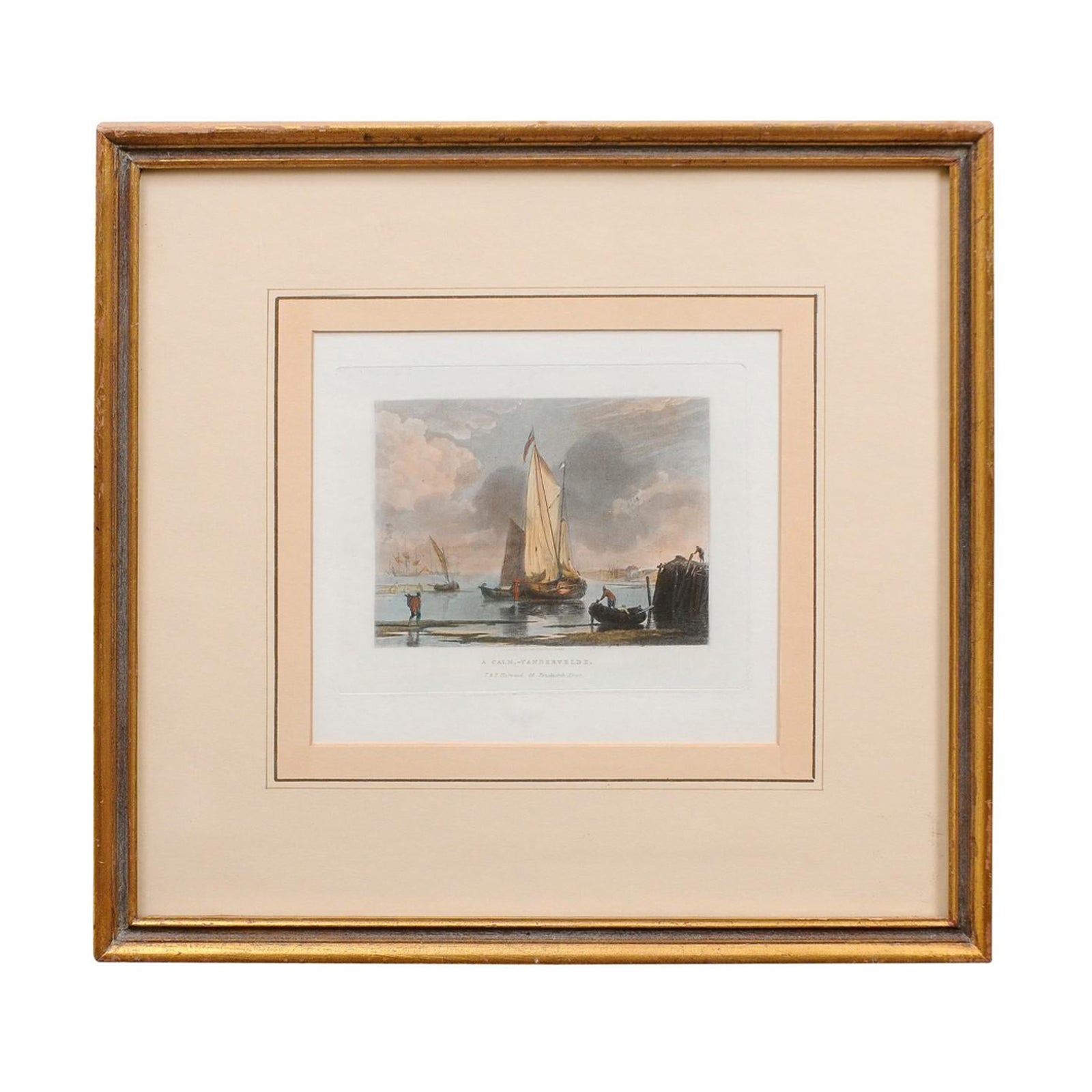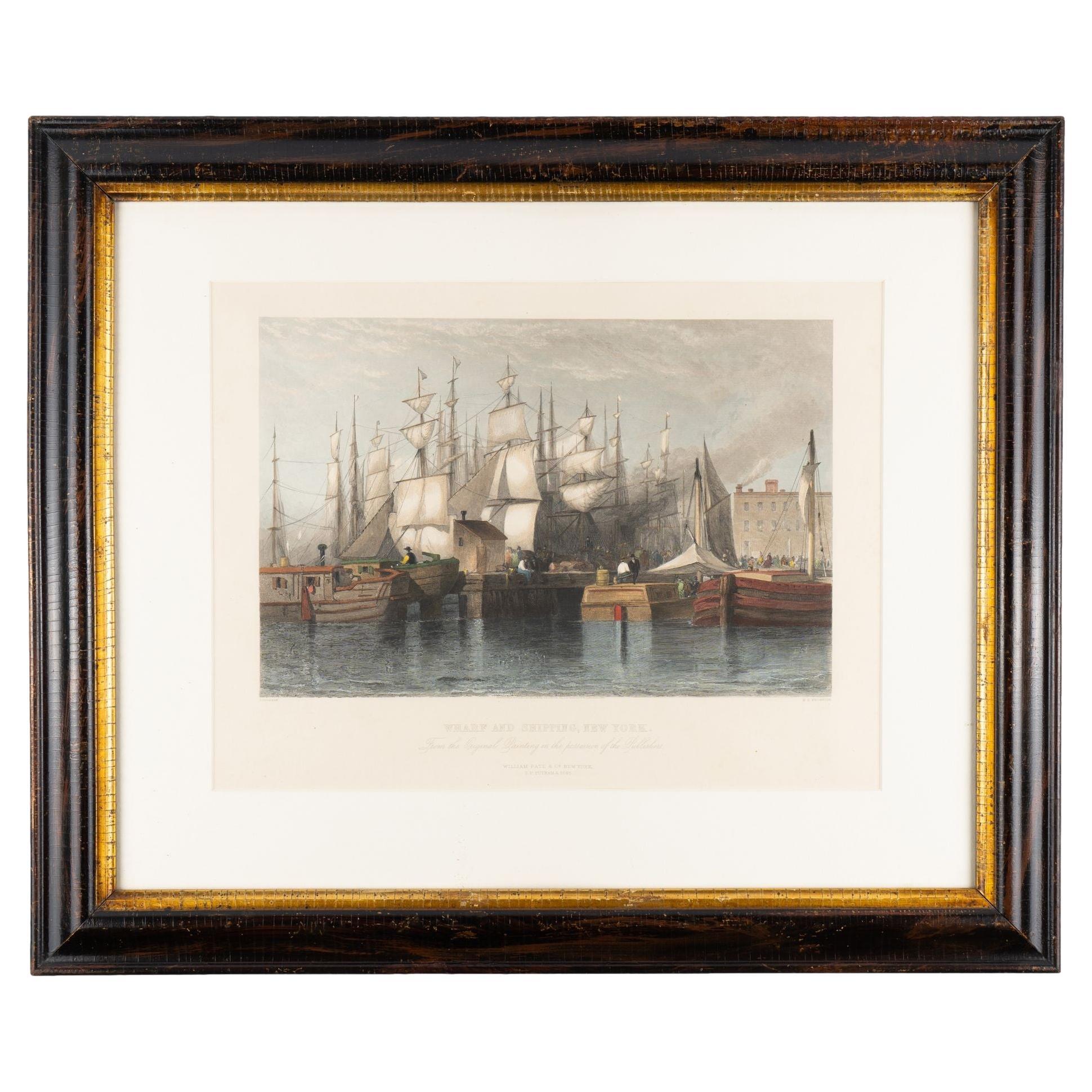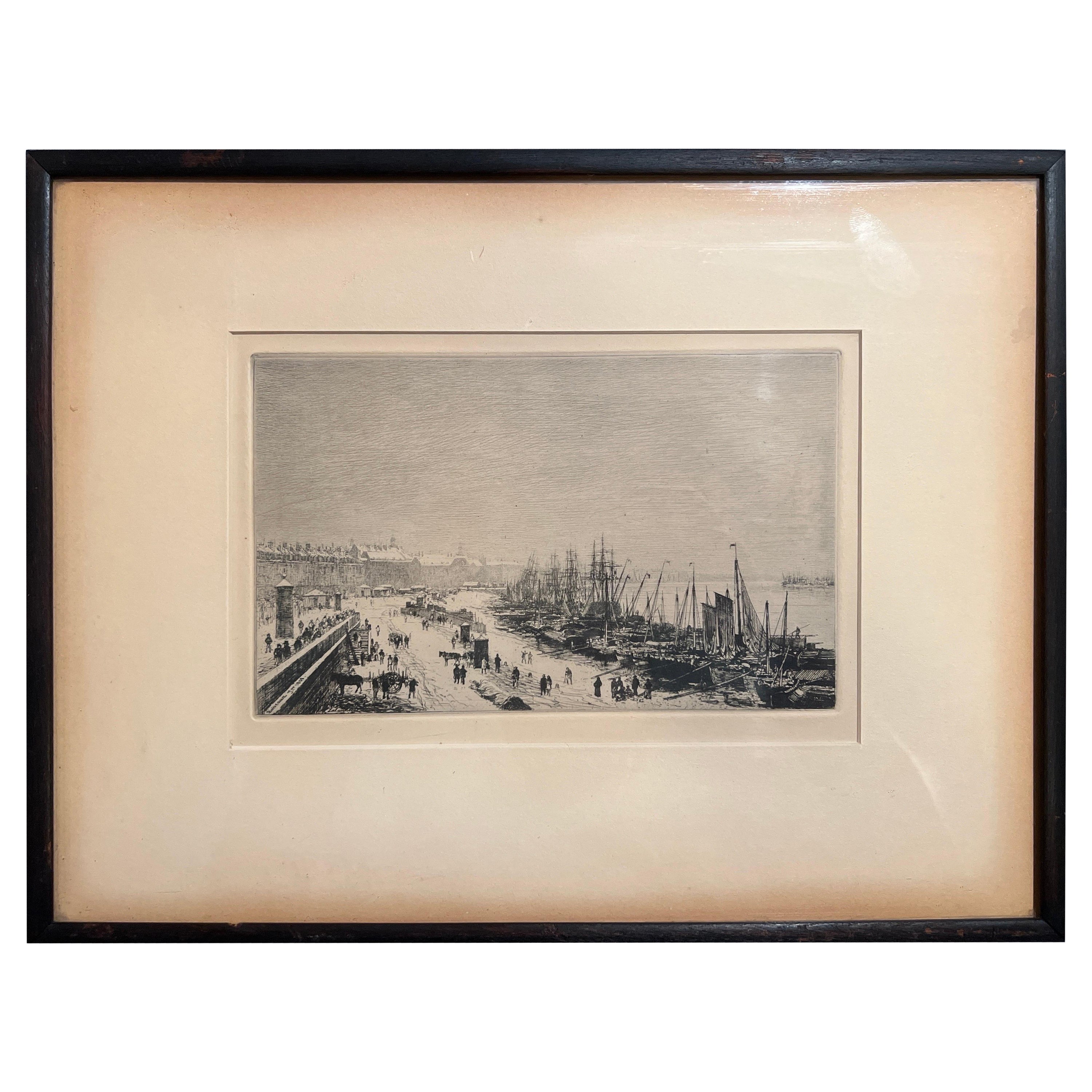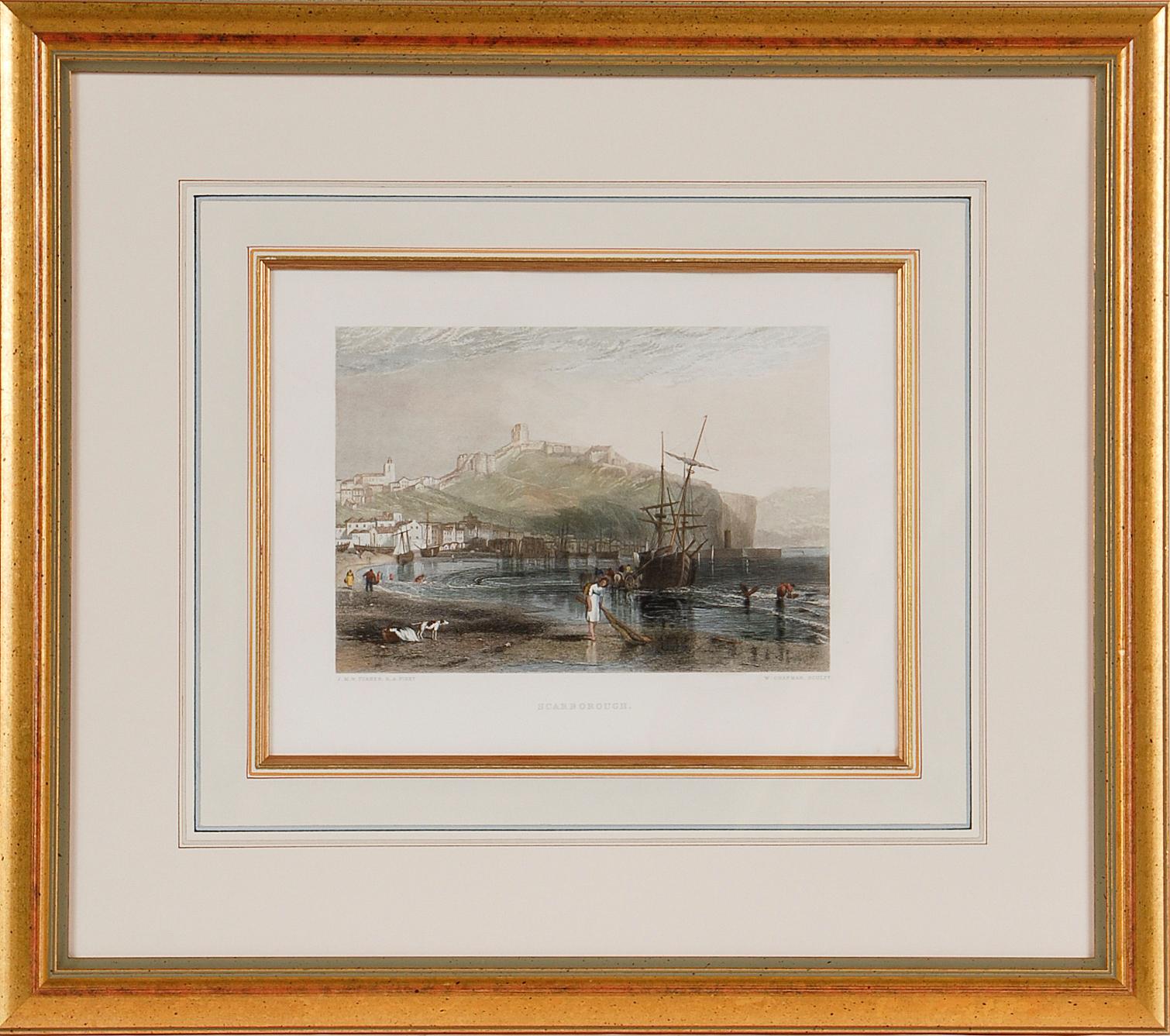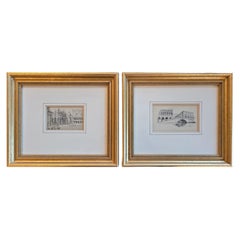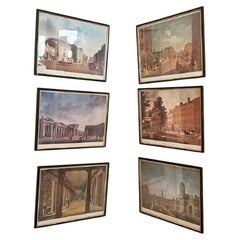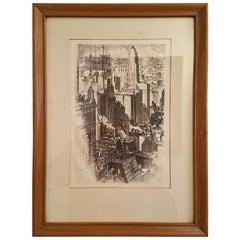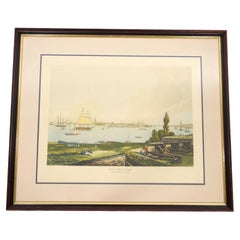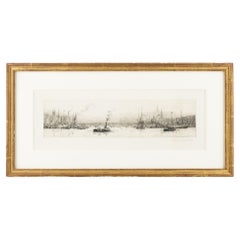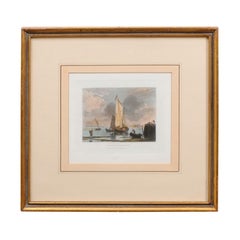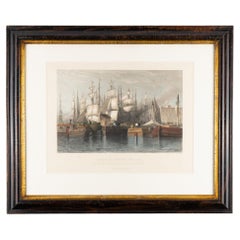Articoli simili a 19C Aquatint Engraving of the Quay at Waterford
Vuoi altre immagini o video?
Richiedi altre immagini o video al venditore
1 di 12
19C Aquatint Engraving of the Quay at Waterford
702,03 €
Informazioni sull’articolo
Presenting a lovely 19C Aquatint Engraving of the Quay at Waterford in Waterford city in Ireland.
This engraving has been hand embellished with aquatint color(s) and is from Ireland circa 1820-40.
It features a scene of the Quay or Port of Waterford from circa 1820. We are basing this upon the attire of the figures in the engraving and the tall ships.
It features Reginald’s Tower (still located at the Waterford Quay to this day). Georgian Quay buildings, a number of moored tall ships and row boats, barrels, horses and carts, women and British soldiers.
The engraving was professionally reframed and matted in Dallas in the 1980’s and the rear of the frame says that it was “Museum Mounted and Matted”. The frame has a lovely Grecian pattern around the front.
If you are Irish, a Waterford Crystal Collector or have your ancestry from Waterford this is a must have !!
This is a very rare engraving !
The name ‘Waterford’ comes from Old Norse Veðrafjorðr ‘ram (wether) fjord‘. The Irish name is Port Láirge, meaning “Lárag’s port”.[6]
Viking raiders first established a settlement near Waterford in 853. It and all the other longphorts were vacated in 902, the Vikings having been driven out by the native Irish. The Vikings re-established themselves in Ireland at Waterford in 914, led at first by Ottir Iarla (Jarl Ottar) until 917, and after that by Ragnall ua Ímair and the Uí Ímair dynasty, and built what would be Ireland’s first city. Among the most prominent rulers of Waterford was Ivar of Waterford.
In 1167, Diarmait Mac Murchada, the deposed King of Leinster, failed in an attempt to take Waterford. He returned in 1170 with Cambro-Norman mercenaries under Richard de Clare, 2nd Earl of Pembroke (known as Strongbow); together they besieged and took the city after a desperate defence. In furtherance of the Norman invasion of Ireland, King Henry II of England landed at Waterford in 1171. Waterford and then Dublin were declared royal cities, with Dublin also declared capital of Ireland.
Throughout the medieval period, Waterford was Ireland’s second city after Dublin. In the 15th century Waterford repelled two pretenders to the English throne: Lambert Simnel and Perkin Warbeck. As a result, King Henry VII gave the city its motto: Urbs Intacta Manet Waterfordia (Waterford remains the untaken city).
After the Protestant Reformation, Waterford remained a Catholic city and participated in the confederation of Kilkenny – an independent Catholic government from 1642 to 1649. This was ended abruptly by Oliver Cromwell, who brought the country back under English rule; his son-in-law Henry Ireton finally took Waterford in 1650 after a major siege.[7] In 1690, during the Williamite War, the Jacobite Irish Army was forced to surrender Waterford in the wake of the Battle of the Boyne.
The 18th century was a period of huge prosperity for Waterford. Most of the city’s best architecture appeared during this time. A permanent military presence was established in the city with the completion of the Cavalry Barracks at the end of the 18th century.[8]
In the early 19th century, Waterford City was deemed vulnerable and the British government erected three Martello towers on the Hook Peninsula to reinforce the existing Fort at Duncannon. During the 19th century, great industries such as glass making and ship building thrived in the city.
The city was represented in the Parliament of the United Kingdom from 1891 to 1918 by John Redmond MP, leader (from January 1900) of the Irish Parliamentary Party. Redmond, then leader of the pro-Parnell faction of the party, defeated David Sheehy in 1891. In 1911, Br. Jerome Foley, Br. Dunstan Drumm and Br. Leopold Loughran left Waterford for Malvern, Australia. Here, they founded a Catholic college which is still in existence today.[9]
In July 1922, Waterford was the scene of fighting between Irish Free State and Irish Republican troops during the Irish Civil War.
- Dimensioni:Altezza: 34,29 cm (13,5 in)Larghezza: 29,21 cm (11,5 in)Profondità: 1,91 cm (0,75 in)
- Stile:Giorgio III (Del periodo)
- Materiali e tecniche:Carta,Inciso
- Luogo di origine:
- Periodo:
- Data di produzione:1820-1840
- Condizioni:Usura compatibile con l’età e l’utilizzo. Very good original condition.
- Località del venditore:Dallas, TX
- Numero di riferimento:1stDibs: LU3978126152682
Informazioni sul venditore
4,9
Venditore Oro
Venditori Premium con valutazione 4,3+ e tempi di risposta entro 24 ore
Fondazione nel 2015
Venditore 1stDibs dal 2018
393 vendite su 1stDibs
- SpedizioneRecupero del preventivo…Spedizione da: Dallas, TX
- Politica di reso
Alcune parti di questa pagina sono state tradotte automaticamente. 1stDibs non può garantire che le traduzioni siano corrette. L’inglese è la lingua predefinita del sito.
Garanzia di autenticità
Nell’improbabile caso in cui si verifichi un problema con l’autenticità di un articolo, contattaci entro un anno per ottenere un rimborso completo. DettagliGaranzia di rimborso
Se il tuo articolo non corrisponde alla descrizione, è danneggiato durante il trasporto o non arriva, contattaci entro 7 giorni per un rimborso completo. DettagliAnnullamento entro 24 ore
Hai un periodo di tolleranza di 24 ore per annullare il tuo acquisto, senza necessità di fornire spiegazioni.Venditori professionali selezionati
I nostri venditori di livello internazionale devono aderire a rigorosi standard di servizio e qualità, garantendo l’integrità delle inserzioni.Garanzia miglior prezzo
Se scopri che un venditore ha pubblicato altrove lo stesso articolo a un prezzo più basso, applicheremo lo stesso prezzo.Consegna globale affidabile
La nostra rete di vettori leader del settore offre opzioni di spedizione specializzate in tutto il mondo, inclusa la consegna personalizzata.Altro da questo venditore
Mostra tuttoCoppia di acqueforti di Venezia di N Erichsen 1904
Presentiamo una bella coppia di acqueforti di Venezia di N Erichsen 1904.
Questa coppia di incisioni è stata disegnata da N. Erichsen, un artista inglese della fine del XIX e dell...
Categoria
Inizio XX secolo, Italiano, Edoardiano, Stampe
Materiali
Carta
Set di 6 stampe irlandesi del XIX secolo con incisioni di scene di Dublino di James Malton
PRESENTA UNA FAVOLOSA E RARA serie di 6 stampe irlandesi incise del XIX secolo di scene di Dublino di James Malton.
Set di 6 stampe incise molto rare e preziose di scene di Dublino,...
Categoria
Di antiquariato/d’epoca, Fine XIX secolo, Irlandese, Giorgio II, Stampe
Materiali
Legno, Carta
Incisione all'acquatinta con scena di caccia EAS Douglas del XIX secolo
Ti presentiamo un'incantevole incisione all'acquatinta con scena di caccia EAS Douglas della fine del XIX secolo.
Colorato a mano e originariamente dipinto da Edward Algernon Stuart...
Categoria
Di antiquariato/d’epoca, Fine XIX secolo, Inglese, Vittoriano, Stampe
Materiali
Carta
Incisione originale di AC Webb del panorama di Chicago nel 1930
Presentiamo una rarissima incisione originale di Alonzo C. Webb della città di Chicago con una veduta di Downtown del 1930.
Questa incisione è in condizioni originali superbe.
...
Categoria
Inizio XX secolo, Americano, Art Déco, Disegni
Materiali
Pergamena
19C Engraving of Lake Gaube in the Pyrenees by T Allom
Di Thomas Allom
Presenting a lovely 19C engraving of Lake Gaube in the Pyrenees by T Allom.
From circa 1850.
Besautiful depiction of Lake Gaube or Lac de Gaube in the French Pyrenees.
Origi...
Categoria
Di antiquariato/d’epoca, Metà XIX secolo, Francese, Vittoriano, Stampe
Materiali
Carta
Acquaforte originale di AC Webb Paris della Mather Tower di Chicago
Presentiamo una rarissima incisione originale di Alonzo C. Webb della città di Chicago con una veduta di Downtown del 1930 circa.
Una registrazione visiva e storica della storia d...
Categoria
Inizio XX secolo, Americano, Art Déco, Disegni
Materiali
Pergamena
Ti potrebbe interessare anche
New York / 1846 Acquaforte acquatinta con cornice di Frederick Caitherwood
Fai un salto nel passato con questa affascinante stampa all'acquatinta intitolata "New York nel 1846 da Governors Island", una copia fedele dello schizzo originale del famoso artista...
Categoria
Inizio XX secolo, Americano, Stampe
Materiali
Carta
Incisione di Londra dai Docklands di Rowland Langmaid, 1926
Incisione su rame widescreen di Londra sul Tamigi dai Docklands.
Inglese, 1926.
Dimensioni: 20-1/4" L x 10-1/8" H x 3/4" D (incorniciato)
Categoria
Vintage, Anni 1920, Britannico, Stampe
Materiali
Carta
Incisione incorniciata del XIX secolo con barca a vela, Londra
Incisione incorniciata del XIX secolo con barca a vela, Londra
Categoria
Di antiquariato/d’epoca, XIX secolo, Inglese, Arte decorativa
Materiali
Carta
Wharf and Shipping, New York di H. H. Beckwith, 1869
Stampa colorata a mano del porto di New York di H. S. Beckwith dopo S. Coleman. Sotto l'opera è stato etichettato "Wharf and Shipping, New York". Dal dipinto originale in possesso de...
Categoria
Di antiquariato/d’epoca, Anni 1860, Americano, Stampe
Materiali
Carta
Maxime Lalanne "Rade de Bordeaux" acquaforte originale C. 1868
Si tratta di un'acquaforte della metà del XIX secolo intitolata "Rade de Bordeaux, Janvier" (Porto di Bordeaux in inverno), realizzata da Maxime Lalanne a Londra nel 1868. L'incision...
Categoria
Di antiquariato/d’epoca, XIX secolo, Francese, Stampe
Materiali
Carta
417 € Prezzo promozionale
20% in meno
Una vista di Scarborough, Inghilterra: Incisione incorniciata del XIX secolo di J.M.W. Turner
Di J.M.W. Turner
Questa bellissima incisione incorniciata del XIX secolo "Scarborough" di W. Chapman è basata su un dipinto originale del famoso artista britannico J.M.W. Turner. Fu pubblicato a Lond...
Categoria
Metà XIX secolo, Romantico, Stampe (paesaggio)
Materiali
Incisione
